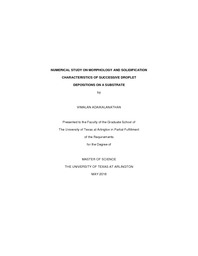
ATTENTION: The works hosted here are being migrated to a new repository that will consolidate resources, improve discoverability, and better show UTA's research impact on the global community. We will update authors as the migration progresses. Please see MavMatrix for more information.
Show simple item record
| dc.contributor.advisor | Tong, Albert Y. | |
| dc.creator | Adaikalanathan, Vimalan | |
| dc.date.accessioned | 2016-06-09T21:14:00Z | |
| dc.date.available | 2016-06-09T21:14:00Z | |
| dc.date.created | 2016-05 | |
| dc.date.issued | 2016-05-10 | |
| dc.date.submitted | May 2016 | |
| dc.identifier.uri | http://hdl.handle.net/10106/25707 | |
| dc.description.abstract | Successive droplet impingement finds extensive applications in additive manufacturing technologies such as 3D printing, Liquid Metal Jetting and Net Form Manufacturing. Deposition, deformation and solidification of droplets are the constitutive stages in the process which determine the final outcome. Detailed knowledge about the flow behaviour, phase transformation and free surface deformation is required to have a complete understanding and optimization of the process parameters. Experimental research in this field is only limited to imaging techniques and post solidification analysis which only provide superficial information while overlooking most of the governing phenomenon. Knowledge of the physics governing the fluid and thermal behaviours can be applied to study the process with real time data pertaining to flow field, temperature profiles and solidification. However, free surface tracking, surface tension modelling, non-isothermal solidification and convection dominant heat transfer pose mathematical challenges in the solution of the governing equations. Moreover, deposition of droplets on pre-solidified splats or non-flat surfaces requires accurate special attention. The objective of the present work is to model the successive droplet impacts and simultaneous solidification and deformation.
The highly non-linear flow field governed by the Navier Stokes equation is solved using a Two Step Projection method. The surface tension effects are accounted for through a Continuum Surface Force technique. One of the crucial elements in the study is the interface tracking algorithm. A Coupled Level Set Volume of Fluid (CLSVOF) method is formulated to give an accurate orientation of the drastically deforming interface and also facilitates generation of multiple droplets in a fixed domain at a user defined frequency, thereby conserving computational resources. The phase change is modelled using an enthalpy formulation of the energy equation with an implicit source term accounting for the latent heat. It is coupled with the flow solver through an Enthalpy-Porosity technique. A modified boundary condition which incorporates the contact resistance has also been implemented.
The case of multiple eutectic solder droplet depositions has been simulated to study the various aspects of splat morphology and solidification characteristics. Effects of impact conditions on single as well as successive droplet depositions have been examined. The role of convection terms in the energy equation has been emphasized and quantitatively analysed. The effect of impact velocity is manifested as surface curvature of the pre-solidified splat and in turn, affects morphology of the subsequent droplets. Initial droplet temperature influences the solidification time of both single and multiple droplets. Under certain conditions, remelting of pre-solidified splat has been observed and its causes have been discussed. Contact resistance has been reported in the literature and has been found to have a strong influence not only on the heat transfer but also the spreading behaviour. Frequency of successive impingements is also an important factor affecting the metallurgical bonding properties. | |
| dc.format.mimetype | application/pdf | |
| dc.language.iso | en_US | |
| dc.subject | Successive droplets | |
| dc.subject | Solidification | |
| dc.subject | CLSVOF | |
| dc.subject | Enthalphy | |
| dc.subject | Porosity | |
| dc.title | Numerical Study on Morphology and Solidification Characteristics of Successive Droplet Depositions on a Substrate | |
| dc.type | Thesis | |
| dc.degree.department | Mechanical and Aerospace Engineering | |
| dc.degree.name | Master of Science in Mechanical Engineering | |
| dc.date.updated | 2016-06-09T21:14:00Z | |
| thesis.degree.department | Mechanical and Aerospace Engineering | |
| thesis.degree.grantor | The University of Texas at Arlington | |
| thesis.degree.level | Masters | |
| thesis.degree.name | Master of Science in Mechanical Engineering | |
| dc.type.material | text | |
Files in this item
- Name:
- ADAIKALANATHAN-THESIS-2016.pdf
- Size:
- 1.805Mb
- Format:
- PDF
This item appears in the following Collection(s)
Show simple item record


